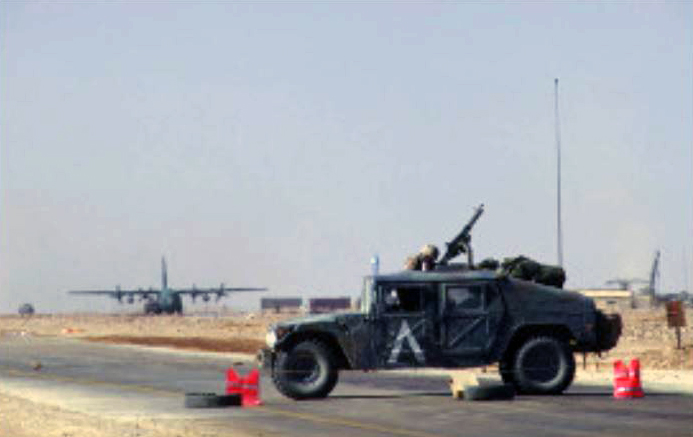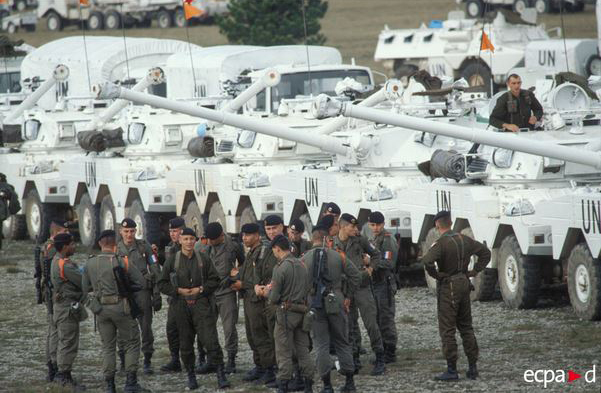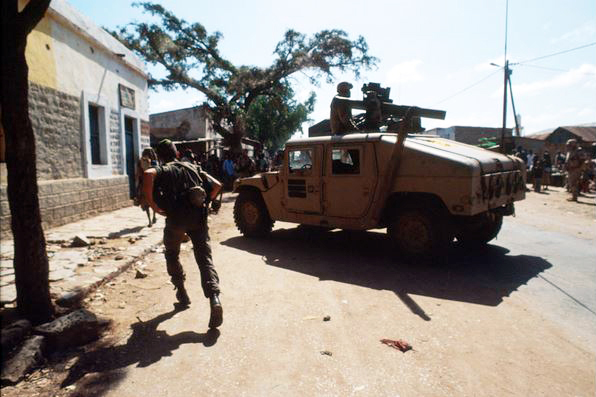1991
Sous-titre
or the advent of a period between strategies

Twenty years ago, on 16 January 1991, airborne military operations were launched as part of the Gulf War. The land offensive then took place over four days, from 24 to 27 February 1991.
Twenty years ago, in 1991, came the end of Comecon(1), the Warsaw Pact and finally, in December, the Soviet Union. The United States emerged as the only surviving superpower, and winners of the Cold War. Indeed, early that year, the USA had affirmed its firepower by winning a swift victory over the army of Saddam Hussein, after he had made the unwise move of invading Kuwait, on 2 August. In a reunified Europe, the Communist regimes had just been abolished and the Maastricht Treaty - signed on 7 February 1992 after being agreed at the European Council of Maastricht in December 1991 - was meant to pave the way for the countries of Central and Eastern Europe, cut off from the West for nearly half a century, to be welcomed into the shared institutions of the European Union. The same treaty, announcing the ambition of a common foreign and security policy, was meant to provide the Old Continent with the necessary instruments to put a stop to the Yugoslav conflict, which had begun with Croat and Slovene independence on 25 June. ”The hour of Europe had dawned”, to use the highly optimistic phrase of Luxembourger Jacques Poos. These illusions of a ”brave new world” left a profound mark on 1991. In practice, they proved to be very short-lived: with the benefit of hindsight, the international system turned out to have just entered a particularly long and uncertain transition.
The main illusion of 1991 was the one created by the Gulf War: that of a new era of primarily interstate conflicts, fought and won ”surgically” in the name of a united international community, thanks to the technological advances of a militarily unbeatable and politically consensual United States. On the contrary, Operation Desert Storm, launched on 16 January 1991 and accomplished by 28 February, was to be the last prototype of an ideal-type model of warfare that was already a thing of the past. The coalition skilfully formed by George Bush senior in 1990, comprising both Arab allies of the United States (like Saudi Arabia, Egypt and Morocco) and other, more reluctant nations (like Syria), would not join forces again for the 2003 Iraq War. A lack of US leadership capable of rallying it was doubtless one reason, but another was the United States' flawed image, both in the eyes of some of its allies and new, emerging powers, who would call into question its management of international affairs. The window of opportunity resting on the hope of global coalitions that represented a unanimous international community in the fight against deviant regimes would quickly close. Just as the image of an omnipotent US army would prove short-lived: Operation Restore Hope, in Somalia (1992-93), ten years before the difficulties encountered in Iraq and Afghanistan from 2003, would highlight the anguish of asymmetrical warfare, for it was no longer one state army pitted against another state army, but instead insurgents, groups, movements, whole societies even. Anachronistic insofar as it was the last war to be fought in political and military conditions that already had no future, the Gulf War nevertheless brought important lessons for a power like France. Prepared for a static war to contain a continental invader before handing over the pursuit of a deterrence strategy to a sovereign national authority, France now found itself forced, in order to maintain its position on the international stage, to switch to a logic of effective, rapid projection, in cooperation with its main allies. The difficulties encountered by Operation Daguet(2) in this regard, in 1991, would quickly be taken into account and, from the mid-1990s, would lead to a new model of professional army, more focused on projection.
The year 1991 might also have led one to believe that a reunited Europe would become a major political actor in the new international system. But the breakup of Yugoslavia underlined its weaknesses, even when faced with a conflict on its doorstep. Europe's first weakness was its inability to interpret international events with a single vision: the profound disagreement between France and Germany on the need to recognise the independence of Slovenia and Croatia showed that foreign policy was not something easily shared, even by the two closest partners. The second weakness was naturally the lack of military resources to back up Europe's word on the world stage. The bearer of a message and a certain approach to international affairs based on law, rules and multilateralism, Europe would turn towards a form of economic and legislative rather than political and military power(3). Meanwhile, national defence budgets in Europe would begin to decrease in this period, raising doubts in the US about the Europeans' desire to continue to play an active international role, or even to defend themselves(4). The third weakness was that, despite its attractiveness, the European model was unable to contain the nationalisms that were thought to be a thing of the past, in its ”near abroad” countries. The violence of the political rhetoric suddenly unleashed in the Balkans, the subsequent harshness of the Chechen conflicts in the Caucasus (1994-96 and 1999-2000), or Israel's intransigence in continuing to favour massive use of force in Lebanon and Palestine(5), would show that the vision of a new, less bellicose world, in which conventional interstate conflict, nationalist rhetoric and territorial rivalries would gradually disappear, remained a very specifically Western European approach, with little currency elsewhere. That gap would lead, among other things, the new democracies of Central and Eastern Europe - from Poland to the Baltic states - to address their demands for security to the North Atlantic Alliance, rather than to the politically nascent Europe.
In many ways, 1991 was, in fact, an illusion. None of the main events that marked it had the expected outcomes: the Gulf War didn't lead to a new consensual world order, the Maastricht Treaty didn't result in a powerful Europe, the fall of the Soviet Union didn't give rise to a conflict-free world within an intelligible international system. The end of bipolarity may have turned the page on an era - that of the Cold War - but the main outcome was an awareness of the sociological complexity of the world: a world long believed - quite wrongly - to be ruled only by the US-Soviet standoff. The signing of a peace treaty in Angola, between the government and UNITA, in May 1991, was not going to put an end to African conflicts long regarded as simply system effects. Nor would the Soviet withdrawal from Afghanistan in February 1989, followed by the collapse of the Soviet power, signal a break with the country's strategic centrality or its paradoxes which, a few years later, would become the epicentre of major conflicts once again. What was hailed as the advent of a new international governance in the hands of a community of states united behind the only remaining superpower (the United States) was in actual fact the dawn of an entirely different era. The world found itself caught between strategies - a situation from which it had still not emerged 20 years later, marked by the confusion of asymmetric wars, the relativisation of US power, the rise of non-state groups or movements (such as Hezbollah and Hamas), the revenge of societies in a media-driven global village (where new information technologies meant more and more people had a voice) and, most of all, the failure of successive global theories(6) to draw up a blueprint for an international system that was unattainable. In the theorists' defence, it should be pointed out that this period between strategies continues to this day, showing no signs of where it will lead or in what timescale.
Frédéric Charillon - Lecturer in political science, Director of the Institut de Recherche Stratégique de l'École Militaire (IRSEM)
(1) Council for Mutual Economic Assistance. Founded in 1949, the role of the organisation was for the different countries of the Communist bloc to assist each other economically.
(2) Trouble deploying approximately 15 000 troops, when the British sent 43 000; trouble conducting certain types of operation; lack of night-vision capability for air sorties; instances of poor compatibility with Allied weapons systems.
(3) Z. Laldl, La Norme sans la Force : l'énigme de la puissance européenne, Presses de Sciences Po, 'Les nouveaux débats' collection, Paris, 2006.
(4) American essayist Robert Kagan illustrates these doubts with a harsh criticism of the weakness of the Europeans. R. Kagan, Of Paradise and Power: America vs. Europe in the New World Order, Knopf Publishers, New York, 2003.
(5) In 1996, in Cana; later in Lebanon, in summer 2006; and in Gaza, in 2008-09.
(6) For instance, Samuel Huntington's ”shock of civilisations”, empirically highly questionable,
or the many expressions proclaiming the end of an era (post-US, post-bipolar world, etc.), without describing the new era. See P. Charillon, 'Un monde paradoxal. Quelles clefs de lecture pour quelle prospective ?', in Futuribles, no 332, July/August 2007.
See also on Educ@Def: Overseas operations

Au PC Olive, une route a été coupée pour la mise en place de véhicules Hummer américains et de camions, et transformée en aéroport. À l'arrière-plan, un avion de transport américain Hercules C-130, Arabie Saoudite, 15 février 1991.
©ECPAD/Didier Charre

Les véhicules militaires et les blindés du 1er RIMa (régiment d'infanterie de marine) et du 126e RI (régiment d'infanterie) sont rassemblés à leur arrivée sur l'autodrome de Rijeka. De couleur blanche et siglés UN (Nations Unies), ils sont destinés aux missions du bataillon français d'escorte des convois humanitaires de la Forpronu, Croatie, octobre 1992.
©ECPAD/Claude Savriacouty


